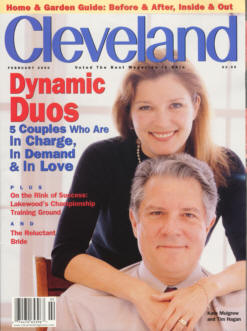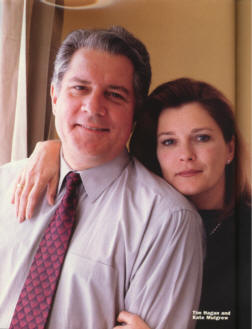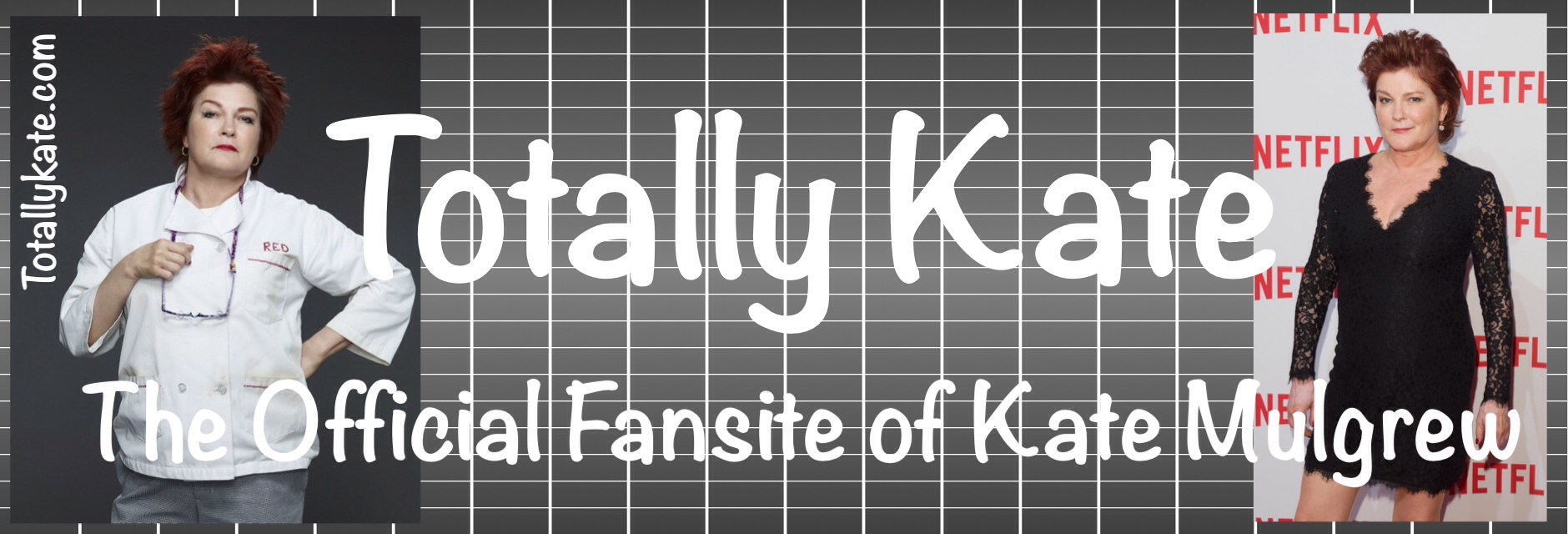 |
February 2000 |
 |
February 2000 |
|
Two to Tango These couples share everything -- from politics to passion. |
 |
|
Photos - Steve Vaccariello |
Tim Hagan Consultant
Kate Mulgrew Actress
The beginning could hardly have been scripted better: Two Irish-Americans, she an actress and he a career politician with ties to the Kennedys, meet for a drink in a hotel bar in western Ireland. It is, naturally, love at first sight.
It was a simple setup: In 1993, Cuyahoga County commissioner Tim Hagan was in Ireland, visiting friends Joan Mulgrew and then-U.S. ambassador Jane (sic) Kennedy Smith. Joan suggested Tim meet her actress daughter Kate, who happened to be vacationing in Ireland at the time.
“And one drink became three days,” Kate Mulgrew recalls.
But the realities of their respective lives — jobs to pursue, young children at homes that happened to be several thousand miles apart — prevented the relationship from moving much beyond that Tralee hotel.
Mulgrew had lived in Los Angeles for almost a decade, acting in TV sitcoms and dramas. Between auditions and shoots, she was also raising two sons. Hagan, meanwhile, was in the midst of a fourth term on the Cuyahoga County Board of Commissioners, and a long-distance relationship coupled with family and work commitments was, he says, a little overwhelming.”
In retrospect, Mulgrew says she knew from the moment she met Hagan that this relationship was different, and that her heart broke when circumstances forced an amicable parting.
“I knew absolutely that this was the love of my life,” she says. “I thought that maybe I could have the strength to love someone as much as I love my craft.”
In some ways, this pairing makes sense for its similarities — both Hagan and Mulgrew are second-oldest children in very large Irish-American families, each has two children, both are well-known in their respective circles — and for the complementary ways in which they communicate their love.
When Mulgrew talks about the man she married in April 1999, she waxes romantic in her distinctively husky voice. One can picture Hagan blushing on the other phone extension in the suburban Los Angeles home they now share. Hagan’s words are slower and more measured, as if he has trouble finding the right descriptives.
Mulgrew admits that in the five years after she first met Hagan, “I never stopped thinking about him.” Hagan, too, knew there was something special: “There was never any one in my life that I was so mesmerized and captivated by.”
The two kept in touch over the years: Hagan called to congratulate Mulgrew when she landed a starring role on a new TV series called “Star Trek: Voyager” in 1994.
“I said to her, ‘Your life is going to change dramatically,’” recalls Hagan, who of course had no idea that the “Star Trek” spin-off would kindle a fresh burst of Trekkie enthusiasm and dramatically enlarge Mulgrew’s professional profile.
Hagan also let Mulgrew know when, in early 1996, he decided not to seek another term as Cuyahoga County commissioner — though he says that decision had nothing to do with the fact that they were planning their wedding for within two years.
Mulgrew and Hagan are children of similarly large, stereotypically solid Irish-American households.
She grew up with seven siblings in Dubuque, Iowa. At 17, she moved to New York City to study acting at New York University, but before finishing at NYU she took the role of Mary Ryan on the ABC soap opera “Ryan’s Hope.”
Two years later, at the ripe age of 23, Mulgrew was offered a starring role in a new TV series — one that had been created for her, no less. Kate Mulgrew became Kate Columbo, wife of Peter Falk’s trenchcoat-wearing, cigar-waving detective. Although “Mrs. Columbo” was a critical success, it ran for just two seasons.
Post-Kate Columbo, Mulgrew went on to earn steady TV work, starring in the award-winning ABC drama “Heartbeat,” playing a Boston city councilwoman on “Cheers,” and in 1991 giving an award-winning portrayal of an alcoholic anchorwoman on an episode of the Candice Bergen sitcom “Murphy Brown.” Mulgrew also appeared in films including “A Stranger is Watching” and the Christopher Lloyd comedy “Camp Nowhere.”
But in 1994, Mulgrew assumed the alter-identity for which she is best known today: Capt. Kathryn Janeway, commander of the Federation starship U.S.S. Voyager and the first starring female leader in the history of “Star Trek” offshoots.
The thrill of landing that role, Mulgrew says, was tempered by the fact that she had met, and for all intents and purposes lost, the love of her life the previous year. “It was an extraordinarily emotional journey for me,’ she says.
Between 1993 and 1998, both she and Hagan tried with varying degrees of success to return to life as usual — Mulgrew, who is divorced from her first husband, stage director Robert Egan, even publicly dated a “Voyager” colleague.
When he learned of that relationship, Hagan says, “I hoped she was happy.” He pauses for a split-second before adding, “Fortunately for me, she wasn’t happy enough.”
It was on the “Voyager” set that Hagan proposed to Mulgrew in November 1998, only five months after they’d become reacquainted romantically.
The engagement had been unofficially sealed the night before, Hagan says, when he told Joan Mulgrew of his plan to marry her daughter. Minutes later, Hagan’s phone rang — it was Jane (sic) Kennedy Smith calling, having heard that Hagan was getting married.
While talking to Smith, another call came through. It was Kate.
“She said, ‘You’re telling everyone we’re getting married except me,’ “Hagan recalls. So the next day, he flew to California with a ring and a formal proposal. “I said, ‘I have the ring,’ and she said, ‘You think you’re getting off that easy after what you’ve put me through?’”
Hagan was ordered to lower himself to one knee. “I said, ‘OK, but at my age I may not be able to get back up.’”
What drew Hagan and Mulgrew back together is hardly a mystery — love at first sight had clearly not been a fluke. The whirlwind five-month courtship, Hagan says, was to make sure they wouldn’t have to test their love again. “I think both of us realized that we had a wonderful relationship and that ... we weren’t going to let it go this time.”
Hagan didn’t dream of a career in politics, but a Cleveland mayoral campaign — an event in which Hagan himself would participate almost 20 years later — whetted his appetite.
The Youngstown native moved to Cleveland in 1970, after serving with the U.S. Army during the Vietnam War, then worked briefly as a steelworker and baker. In Cleveland, Hagan worked on James Carney’s unsuccessful mayoral campaign, during which time he met his future wife, Carney’s niece, Jeanne, and a number of important Clevelanders who would support Hagan’s own political aspirations in the coming years.
Five years after he and Jeanne married in 1973, Hagan became chairman of the Cuyahoga County Democratic Party, in which capacity he kindled a lifelong friendship with the Kennedy family by endorsing senator and presidential candidate Edward Kennedy over Democratic rival Jimmy Carter.
Hagan was elected to the first of four four-year terms as a Cuyahoga County commissioner in 1982. He and his fellow commissioners were responsible for funding and overseeing some of the most important development projects in Greater Cleveland’s recent history, from the Rock and Roll Hall of Fame and Museum to the Gateway sports complex.
His friendship with the Kennedy family thrived, as well. Sen. Edward Kennedy and Ethel Kennedy have campaigned for Hagan. Hagan is godfather to Robert F. Kennedy’s granddaughter, Kate Kennedy Townshend; (sic) and was a pallbearer at the funeral of Sen. Kennedy’s brother-in-law, Steven Smith.
Hagan’s political path has not been without its potholes. He lost a 1989 mayoral primary bid to state Sen. Michael R. White, who subsequently defeated then-Cleveland City Council president George Forbes.
Hagan also lost when, in 1992, he challenged incumbent congresswoman Mary Rose Oakar. And during his tenure on the county commission, Hagan was associated with the Secured Assets Fund Earnings (SAFE) scandal, in which the county took a $115 million hit when forced to liquidate the allegedly risk-free investment fund.
It is a measure of Hagan’s popularity and personality, though, that he was re-elected while the SAFE scandal still raged, and that he later counted former rivals White and Forbes— the latter once called Hagan a “pimp” — among his friends.
Hagan has said that he is “stuck in the ‘60s,” a time that shaped his liberal passions to help the poor and to use the power of government to positively affect constituents’ quality of life. He’s rather old-fashioned that way, a self-described “unreconstructed FDR New Dealer.”
In the winter of 1996, Hagan, by then divorced and sharing custody of daughters Eleanor and Marie, announced his retirement as a county commissioner, although for Hagan, “retirement” is a relative term: he works as a consultant to Cleveland State University, MetroHealth Medical Center and the Mandel Foundation. Late last year, he publicly flirted with the notion of challenging U.S. Sen. Mike DeWine, an idea since dropped but not completely abandoned. Neither Hagan nor Mulgrew talks about plans beyond the next few years.
“We’re just looking forward to the time when Kate will be in Cleveland,” Hagan says.
As his wife puts it: “There’s a huge light at the end of this tunnel.”
It wasn’t Mulgrew’s plan to settle in Los Angeles, which she calls “a dangerous place” and “a very difficult place to raise children.” Despite 16 years there, she still doesn’t sound as if she’s talking about home — she’s “been in” California for 16 years, not “lived in” California.
“There’s a sense of isolation [there] that I don’t have in Cleveland or Dubuque or certainly in New York City,” she says.
Capt. Janeway is so strongly associated with the actress that it’s sometimes difficult to reconcile Mulgrew’s very different traits. Janeway, with her precisely coiffed hair and tailored uniform, is stoic and authoritative, the quintessential stabilizer who never shows extremes of emotion. But in real life, Mulgrew lets her auburn hair fall loosely to her shoulders, and in casual conversation is animated, open and friendly.
Today, Mulgrew has fan clubs and Web sites devoted to her —and to Capt. Janeway. In addition to the official “Star Trek: Voyager” pages on the UPN site, Mulgrew is the subject of Web sites including “Captain Kate,” “Totally Kate!” and “The Kate Mulgrew Appreciation Society,” an “official” fan club that publishes a newsletter titled, appropriately, “Now Voyager.”
Perhaps the best gauge of having arrived is not the stack of TV Guide magazines bearing Mulgrew’s likeness on the covers, but the fact Capt. Janeway merits a satire site called “The Captain Jayn Safeway Page.”
It’s odd, Hagan says, that after 25 years in public life, he is known as “Capt. Janeway’s husband.”
Mulgrew has one more season — her seventh — to go on her “Voyager” contract, after which she plans to see the youngest of her two sons off to college and settle, more or less permanently, in Northeast Ohio.
It will be a dramatically different setting from Mulgrew’s suburban Los Angeles home: A few years ago, Hagan bought land in Olmsted Township, on which he has built a comfortable house and facilities for his daughters’ horses.
Mulgrew hopes to return to the stage and will likely also keep an apartment in New York City. “Of course, given all the other dynamics of life, who knows?” she allows.
One thing is certain: Neither Hagan nor Mulgrew is wild about the commuter-marriage arrangement they’ll have to maintain for at least the next year.
“Right now, Tim is doing the lion’s share of self-sacrifice, which is hard for me to watch,” Mulgrew says. “We’re managing, but it’s not a bowl of cherries.”
Any commuting couple can attest to the discipline and commitment required. “A different kind of discipline,” Mulgrew says, that takes into account not just physical, but emotional factors. “Most married couples have one another at the end of the day,” she says. “There’s a consistent sense of intimacy and sharing. We have to be very careful, because we don’t have each other at the end of the day.
“The greatest risk with this kind of separation is the imminent danger of sadness,” she adds. “I particularly have to watch that. My need for his physical presence is great, and often it just can’t be met.”
It seems almost out of character for Mulgrew to admit to weakness, after having forged a successful career and raised two sons in an exceedingly difficult setting, but she is frank: “For the first time in my life with a man, I have risked complete vulnerability. Which is the highest compliment I can pay him.”
Even when Hagan is in Los Angeles, Mulgrew’s schedule keeps the couple separated for most of the day: “Voyager” shoots for 10 months of the year, sometimes seven days a week, often requiring Mulgrew —who leaves for the studio at 5 a.m. —to put in 14-hour days.
Hagan is philosophical about the overstretched schedules and crowded circumstances in which he and his wife have operated for much of their lives, first as children of huge families, then as working parents.
“Fortunately for both of us, our sense of life was fashioned long before the last eight or 10 years,” he says. “We share a real foundation — we are shaped in large part by the social messages of our church and [our families].
“I think it makes it easier in many respects,” he adds. “We share a common feeling that life is not just what you’re interested in. Other people are making demands. You have to learn to measure our time with everyone.”
Which is a polite way, perhaps, of saying that being in the same house won’t solve every problem of separation or erase outside obligations — neither plans to stop working, after all, and both will gain two stepchildren and a new crowd of in laws. (Mulgrew says the first time she encountered a roomful of Hagans, she felt like Capt. Janeway being interviewed for an important new Starfleet assignment.)
The couple’s current forced separation is infinitely easier, at least, than the break that followed their intense first meeting. And the future is bright, Mulgrew says.
“Tim and I find great comfort in one another,” she says. “The greatest joy is understanding that we value the same things and, curiously for people who have led pretty exciting lives, those things are laughter, love ... and hope.”
Many THANKS to a Totally Kate! contributor for the Cleveland
Magazine
[HOME] [ARTICLES][BIO][CON REPORTS][FILMOGRAPHY] [TV INTERVIEWS][PHOTOS] [LINKS][ODDS 'N ENDS]
 |